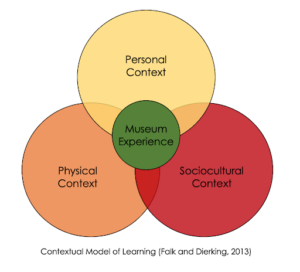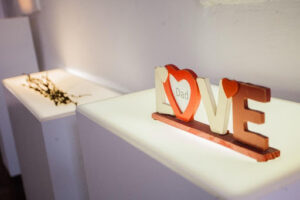By Jennifer Mott
From the thrilled look on my professor’s face at the beginning of our Museum Education class session, I could tell she had big news. However, I could not have guessed the amount of personal excitement that her news would bring me. Our discussion this week focused on some foundational questions that underlie museum education practice: namely, what is “the museum experience,” why do some people go to museums while others do not, and how do museums themselves foster exclusion or inclusion? As usual, we were assigned more readings than I may have wanted at first, but each proved insightful and provocative. It was difficult for me to find much to complain about. Not to mention the fact that Professor Silverman’s positive energy was highly contagious and piqued my curiosity about what was coming next.
We began with a close look at a classic model for unpacking and analyzing museum experiences, including our own. “The contextual model of learning,” presented by John H. Falk and Lynn D. Dierking in The Museum Experience Revisited (2013), visualizes a museum visit as an interaction between three different but interrelated contexts that together constitute “the museum experience.” The personal context includes individual factors, like one’s expectations and interests; the sociocultural context includes cultural influences, like norms about museum visiting; and the physical context includes elements like the museum architecture, the exhibit content, and even the presence or absence of accommodations for people with disabilities (26). In short, the model reveals there are many factors at play that inform and explain why someone may have a positive or negative experience in a museum or even choose whether to go at all. As museum professionals, we must consider all three contexts and keep in mind that visitors bring unique personalities and needs of their own when they walk in the door (27). Because of this, some people find that museums offer nothing of significance for them.

Contextual Model of Learning in Falk and Dierking’s 2013 book, The Museum Experience Revisited.
The physical context in particular helps us examine what museums offer and contribute to the visitor experience, from their collective history to their current staff to the environment they create. One reason some people are not interested in visiting museums is that they do not feel comfortable in them. Museums were historically designed for and run by specific types of people (European white men) so if you do not fit that description, it is easy to feel excluded. In his chapter “Positioning the Museum for Social Inclusion” (2013), David Fleming drives home how this problem occurs: if we can only see our own perspective and understand our own position, then the lack of diversity among museum decision-makers will create and maintain exclusivity instead of inclusivity. As Fleming says, “it is no surprise, then, that a sector that recruits staff from a particular stratum of society has managed to create a product that appeals most to others from the same stratum” (214).
With our readings in mind, we then discussed what museums can do and have been doing to be more cognizant and inclusive of multiple perspectives. We shared some examples of inspiring museums and strategies. By this point in class, Professor Silverman was busting to share the big news, and she finally did. Our class this semester is partnering with the Museum of Broken Relationships, an international, crowd-sourced project that is a remarkable model of museum inclusion. MBR’s purpose is to connect people around the world by collecting and displaying individual objects and anonymous stories related to heartbreak. By doing this, they have fostered inclusion, promoted empathy, and facilitated healing experiences for visitors and contributors of all kinds. The co-creators of this beautiful project, Olinka Vištica and Dražen Grubišić, will partner with the IUPUI Museum Studies Program to build a remarkable MBR exhibition in Indianapolis. And our Museum Education class will be developing public programs to accompany it!

Museum of Broken Relationships display showing donated objects. Image Credit: Alan Vajdić, Museum of Broken Relationships.
Upon reflection, I now realize that our larger aim is to understand what makes a socially inclusive museum experience and how to design educational programs that work to that end. As Fleming (2002) stresses, this is not a job that will be completed quickly. To reach a wider audience and create a space where everyone feels welcome and safe, the museum must become an instrument to “help the process of social change and regeneration, nothing less” (224). In partnership with the Museum of Broken Relationships, our Museum Studies Program has the exciting opportunity to welcome objects and stories from throughout the city of Indianapolis and to create empathetic environments for visitors to connect, reflect, and learn. The Museum of Broken Relationships sets a bold example of what it looks like to be an innovator for inclusion and social change, and I am very much looking forward to the opportunity to learn from and share in their dream.
Jennifer Mott is a first-year MA student in the IUPUI Museum Studies Program.
References
Falk, John H. & Lynn D. Dierking. 2013. The Museum Experience Revisited. California: Left Coast Press.
Fleming, David. 2002. “Positioning the museum for social inclusion.” Museums, Society, Inequality edited by Richard Sandell. London and New York: Routledge.
Museum of Broken Relationships. 2022. “Explore the Museum.” Museum of Broken Relationships. September, 2022. https://brokenships.com/explore.

